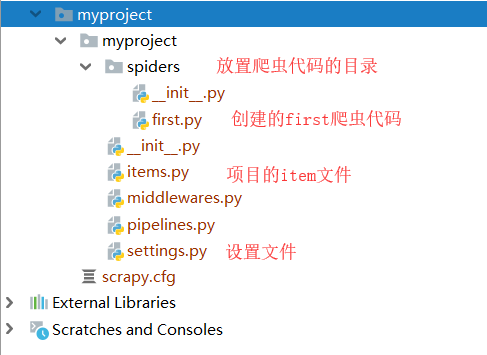---恢复内容开始---
scrapy
Scrapy 是一个为了爬取网站数据,提取结构性数据而编写的应用框架。 可以应用在包括数据挖掘,信息处理或存储历史数据等一系列的程序中。
1.安装环境
MAC下:
pip install scrapy
Win系统下:
a. pip3 install wheel b. 下载twisted http://www.lfd.uci.edu/~gohlke/pythonlibs/#twisted c. 进入下载目录,执行 pip3 install Twisted‑17.1.0‑cp35‑cp35m‑win_amd64.whl d. pip3 install pywin32 e. pip3 install scrapy
2.执行流程
在terminal中输入指令:
创建一个工程:
scrapy startproject first_project
创建爬虫文件:
cd first_project # 进入工程目录
scrapy genspider first www.xxx.com # 创建爬虫文件
scrapy genspider 应用名称 爬取网页的起始url (例如:scrapy genspider qiubai www.xxx.com)
执行项目:
scrapy crawl first
scrapy crawl 爬虫名称 :该种执行形式会显示执行的日志信息
scrapy crawl 爬虫名称 --nolog:该种执行形式不会显示执行的日志信息
保存数据
scrapy crawl first -o items.json
生成的具体目录如下

基本配置与实现
1.爬虫文件first.py
# -*- coding: utf-8 -*- import scrapy class FirstSpider(scrapy.Spider): #爬虫文件的名称 name = 'first'
#允许的域名,一般情况不写,因为爬取图片等资源时,常用到跨域,这样把域名限制后会出现问题 # allowed_domains = ['www.baidu.com']
#起始的url列表:列表中存放的url都会被scrapy进行自动的请求发送 start_urls = ['https://www.baidu.com/','https://www.sogou.com'] #解析数据,访问起始URL并获取结果后的回调函数,该函数的response参数就是向起始的url发送请求后,获取的响应对象.
#该函数返回值必须为可迭代对象或者NUll def parse(self, response): print(response.text) # 获取字节类型的响应内容
print(response.body) # 获取字节类型的相应内容
2.设置修改settings.py配置文件相关配置
# 设置user-agent USER_AGENT = 'Mozilla/5.0 (Windows NT 6.1; Win64; x64) AppleWebKit/537.36 (KHTML, like Gecko) Chrome/70.0.3538.77 Safari/537.36' # 忽略,不遵守Robots协议 ROBOTSTXT_OBEY = False # 设置item类的优先级 ITEM_PIPELINES = { #300表示的是优先级(数值越小优先级越高) 'firstBloof.pipelines.QiubaiproPipeline': 200, 'firstBloof.pipelines.MysqlPipeLine': 301, 'firstBloof.pipelines.RedisPipeLine': 401, }
# 日志类型:INFO DEBUG ERROR
LOG_LEVEL = 'ERROR'
数据的持久化存储
示例: 爬取糗百首页中段子的内容和标题
# -*- coding: utf-8 -*- import scrapy from qiubaiPro.items import QiubaiproItem class QiubaiSpider(scrapy.Spider): name = 'qiubai' # allowed_domains = ['www.xxx.com'] start_urls = ['https://www.qiushibaike.com/text/'] #终端指令的持久化存储:只可以将parse方法的返回值存储到磁盘文件 # def parse(self, response): # div_list = response.xpath('//div[@id="content-left"]/div') # all_data = [] # for div in div_list: # # author = div.xpath('./div[1]/a[2]/h2/text()')[0].extract() # author = div.xpath('./div[1]/a[2]/h2/text()').extract_first() # content = div.xpath('./a/div/span//text()').extract() # content = ''.join(content) # # dic = { # 'author':author, # 'content':content # } # # all_data.append(dic) # # return all_data #基于管道的持久化存储 def parse(self, response): div_list = response.xpath('//div[@id="content-left"]/div') all_data = [] for div in div_list: # author = div.xpath('./div[1]/a[2]/h2/text()')[0].extract() author = div.xpath('./div[1]/a[2]/h2/text()').extract_first() content = div.xpath('./a/div/span//text()').extract() content = ''.join(content) #实例化一个item类型的对象 item = QiubaiproItem() #使用中括号的形式访问item对象中的属性 item['author'] = author item['content'] = content #将item提交给管道 yield item